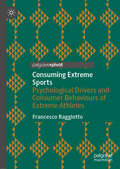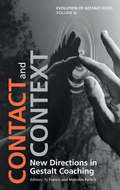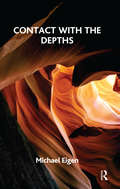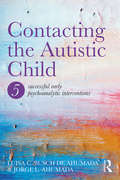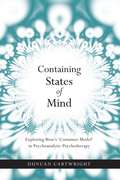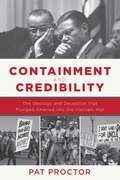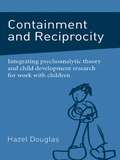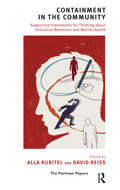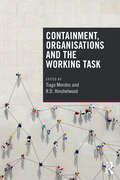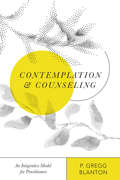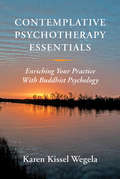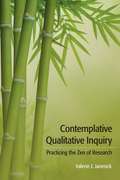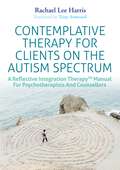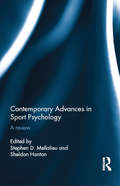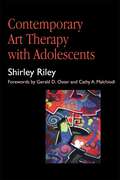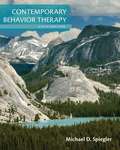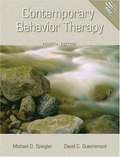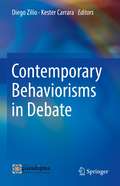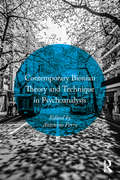- Table View
- List View
Consuming Extreme Sports: Psychological Drivers and Consumer Behaviours of Extreme Athletes
by Francesco RaggiottoThis book explores the consumption behaviour of ‘extreme’ athletes from a quantitative perspective. Extreme sports are a multi-billion-dollar industry. The behaviour of athletes who participate in them differs from the majority of consumers in that they voluntarily seek out risky and dangerous situations that other consumers actively avoid. It has therefore been suggested that these consumer-athletes may have a unique psychology in this regard. The book adopts a novel approach based on established psychological theories concerning the behaviour of extreme individuals, applying and translating them into marketing research and practice. It discusses how specific psychological drivers impact the consumption behaviour of consumer-athletes and a variety of marketing-relevant outcomes. By demonstrating that extreme consumers are characterized by a unique psychology that leads them to act and think differently, this book offers scholars deeper insights into consumer behaviour, while also helping practitioners target this lucrative marketing segment more effectively.
Consuming Habits: Global and Historical Perspectives on How Cultures Define Drugs (2nd edition)
by Paul E. Lovejoy Jordan Goodman Andrew SherrattCovering a wide range of substances, including opium, cocaine, coffee, tobacco, kola, and betelnut, from prehistory to the present day, this new edition has been extensively updated, with an updated bibliography and two new chapters on cannabis and khat. Consuming Habits is the perfect companion for all those interested in how different cultures have defined drugs across the ages. Psychoactive substances have been central to the formation of civilizations, the definition of cultural identities, and the growth of the world economy. The labeling of these substances as 'legal' or 'illegal' has diverted attention away from understanding their important cultural and historical role. This collection explores the rich analytical category of psychoactive substances from challenging historical and anthropological perspectives.
Contact and Context: New Directions in Gestalt Coaching
by Ty Francis Malcolm ParlettThis collection brings together some leading figures in Gestalt coaching to take stock of the field and consider how it might move forward. It covers the principles of Gestalt coaching and encourages practitioners to rethink the application of Gestalt in new ways and new settings – e.g. leadership, management and team development. Individual chapters also explore radical and personal perspectives on Gestalt coaching, from considering the place of embodiment to ‘being’ in coaching practice and looking at the transformational micro-moments of the client encounter.
Contact with the Depths
by Michael EigenThis book explores ways we make contact with the depths in ourselves and each other. We are deeply moved by contact we make with life, yet also puzzled by a need to break or lose contact, and often suffer wounds by failure of contact to be born. Our sense of contact is tenacious and fragile, subject to deformations, plagued with a sense of jeopardy. Chapters focus on ways we make-and-break contact in the wounded aloneness of addiction, the wounded beauty of psychosis, the importance of not knowing and wordlessness, ways we transmit emotions, the need to start over, and harm we cause by trying to get rid of and misuse tendencies that are part of our makeup. Our contact with life, ourselves, each other is challenged. And through it all, we have need for deep contact, contact with the depths, fulfilling and suspenseful. Contact we never stop growing into, part of the mystery, care and love of everyday life.
Contacting the Autistic Child: Five successful early psychoanalytic interventions
by Jorge L. Ahumada Luisa C. AhumadaAmid long-standing controversy on their causes, which most regard as neurological, and despite their increasing social impact, there has been scant progress in the therapy of the autistic spectrum disorders. Currently fashionable attempts at treatment through behavioural-cognitive focal approaches do not seek resolution, only re-education and rehabilitation. Contacting the Autistic Child explores the clinical process in the early psychoanalytic treatment of autistic children. Organised around five detailed clinical case studies, and drawing on the ideas of major clinicians in child analysis such as Tustin, Winnicott and Alvarez, this book sets out a clear programme for working with and understanding autistic children in a psychoanalytic setting, with a particular focus on issues of clinical technique but also conceptual matters. Working on the notion that autistic disorders come to be – as Winnicott and Tustin saw it – from an early rupture of the affective communication between baby and mother, this book aims at reinstating such communication in the child-analyst interaction. By way of detailed description of what goes on in the analytic link, the authors strive to make the reader share in what goes on in the clinical setting, evincing how, though at times excruciatingly hard on the therapist, resolution is attainable. Once the "primal dialogue" – to use René Spitz’s terms – is reinstated in a stable way in session, it flows by itself into the family ambience. The clinical accounts of this book make the argument that psychoanalysis, carried along Tustin’s technical lines, and subject to the proviso that treatment starts early, preferably in the first three years of life, is the treatment of choice for autistic spectrum disorders. The strong methodological narrative is important and notable in light of the doubts, criticism and uncertainty that have surrounded the psychoanalytic treatment of autism. This novel, highly detailed narrative of five successful early treatments aims to help dispel the pessimism pervading the field and help to redress the lives of many more children. Contacting the Autistic Child will appeal to psychoanalysts and psychoanalytic psychotherapists endeavouring to obtain results in a major area lacking resolutive approaches.
Containing Madness: Gender and ‘Psy’ in Institutional Contexts
by Jennifer M. Kilty Erin DejThis collection explores the discursive production and treatment of mental distress as it is mediated by gender and race in different institutional contexts. Featuring analyses of the prison, the psychiatric hospital, immigration detention, and other locales, this book explores the multiple interlocking oppressions that result in the diagnosis and medical, psychological, and psychiatric treatment of individuals constituted as ‘mentally ill’ at various historical moments and across institutional spaces. Contributors unpack how feminine, masculine, and transgender bodies are made up as mentally ill/sick/deviant by way of biomedical and institutional knowledges and discourses and are intervened upon by different institutional and expert authorities.
Containing States of Mind: Exploring Bion's 'Container Model' in Psychoanalytic Psychotherapy
by Duncan CartwrightWilfred Bion’s insights into the analytic process have had a profound influence on how psychoanalysts and psychotherapists understand emotional change and pathological mental states. One of his most influential ideas concerns the notion that we need the minds of others to develop our own emotional and cognitive capacities. In Containing States of Mind Duncan Cartwright explores and develops some of the implications that Bion’s container model has on clinical practice. He argues that the analyst or therapist best fulfils a containing function by negotiating irreconcilable internal tensions between his role as ‘dream object’ and ‘proper object’. The container model is also used to illustrate different ‘modes of interaction’ in the analytic field, the nature of particular pathological states and some of the key dilemmas faced in attempting to make unbearable mental states more bearable. As well as addressing key theoretical problems, Containing States of Mind is a clinical text that renders complex ideas accessible and useful for psychotherapeutic and analytic practice and as such will be essential reading for all those involved in the fields of psychoanalysis and psychotherapy.
Containment and Credibility: The Ideology and Deception that Plunged America into the Vietnam War
by Pat ProctorIs it possible that a president and his administration would purposefully mislead the American public so that they could commit the United States to a war that is not theirs to fight? Anyone with even a remote memory of the phrase "weapons of mass destruction” probably finds such a question naive. On the eve of the fiftieth anniversary of the Vietnam War, those with longer memories would consider the unquestioning acceptance of Saddam Hussein’s "gathering threat” even more naive. Providing historical context that highlights how the decision to use force is made, as well as how it is "sold,” Containment and Credibility explores how the half-truths and outright lies of both the Johnson and Nixon administrations brought us into a conflict that cost more than fifty thousand American lives over eight years. As we consider how best to confront the growing threat of ISIS, it is increasingly important for the public to understand how we were convinced to go to war in the past. In the 1960s, the domino theory warning of the spread of communism provided the rationale for war, followed by the deception of the Gulf of Tonkin Incident and the resulting resolution that essentially gave LBJ a blank check. This book will show how this deception ultimately led to the unraveling of the Johnson presidency and will explore the credibility gap that led to the public political debate of that time. Containment and Credibility applies the lessons of the sixties to today’s similar debates regarding military involvement. Skyhorse Publishing, as well as our Arcade imprint, are proud to publish a broad range of books for readers interested in history--books about World War II, the Third Reich, Hitler and his henchmen, the JFK assassination, conspiracies, the American Civil War, the American Revolution, gladiators, Vikings, ancient Rome, medieval times, the old West, and much more. While not every title we publish becomes a New York Times bestseller or a national bestseller, we are committed to books on subjects that are sometimes overlooked and to authors whose work might not otherwise find a home.
Containment and Reciprocity: Integrating Psychoanalytic Theory and Child Development Research for Work with Children
by Hazel DouglasContainment and Reciprocity shows how the psychoanalytic concept of containment and the child development concept of reciprocity can be used together to inform clinical work with young children and their families. Using extracts of mother/child and therapist/child interactions, Hazel Douglas explores, for the first time, the relationship between these concepts, and shows how they underpin the quality of an attachment. Using clinical examples from the author’s own psychoanalytic work with very young children as well as her recent research, the book explores these two concepts with important implications for psychotherapeutic technique. Containment and Reciprocity will make valuable reading for all those working in the field of infant mental health.
Containment in the Community: Supportive Frameworks for Thinking about Antisocial Behaviour and Mental Health (The\portman Papers Ser.)
by Alla Rubitel David ReissThis book is aimed at all practitioners working in healthcare and criminal justice community settings with individuals displaying antisocial, offending, and challenging behaviours, at times complicated by severe mental disorders. Despite risk assessment policies and procedures, we all know how disorientated we can feel when trying to make sense of what is going on in the course of our work. Contributors to this book describe familiar anxiety-provoking situations. Most importantly, they illustrate ideas and perspectives that can help you to rediscover meaning and purpose in your roles and tasks, with the ultimate objective of enabling service-users to manage more effectively the emotional turbulence that invariably lies behind their challenging behaviours.
Containment, Organisations and the Working Task
by Tiago Mendes HinshelwoodWith close attention to Wilfred Bion's influence on the literature about groups and organisations, this book explores how containment has been transposed from the clinical setting to enlighten the work being carried out by psychodynamic practitioners and researchers, especially within organisations.In the first part, contributors explore the origins of containment, comparing and contrasting it with similar concepts such as holding. A second part is devoted to addressing the implications of utilising psychoanalytic ideas beyond the couch and bringing them to the social field of groups and organisations. The early days of such ideas, as well as the wide range of methods applied, are also addressed in this section with the aim of giving the reader a more comprehensive base for the application of psychoanalytic knowledge. Finally, the third part provides a detailed view of the different applications of containment in consulting, leadership, therapeutic communities and group relations. Drawing on their own experiences, the authors highlight how psychoanalytic concepts impact their own practice, contributing to a collection that will prove essential for psychoanalysts, managers, policymakers, consultants and researchers in a wide range of professional and clinical settings.
Contemplating Climate Change: Mental Models and Human Reasoning (Routledge Advances in Climate Change Research)
by Stephen M. DarkGlobal climate change policy has failed us all, but what is the reasoning that underlies this failure? Why are some people more disposed to reflect on confounding issues like climate change, recognise the danger, seek a solution, and act accordingly, more than others? This book is concerned with how we think and act in response to climate change. In particular, faced with deep uncertainty and the multifaceted complexities that characterise the climate change conundrum, how the various actors and institutions involved in the policymaking process make decisions that both aid and impede in the design and implementation of climate change policy. This book focuses on how these actors and institutions frame and use the knowledge available – under conditions of competing ideologies and interests – and synthesise it to form often-disparate mental models, or worldviews, that inspire them to become firm advocates of meaningful climate change action or indeed, sceptics that continue to downplay the threat, and hence the need for urgency. By exploring how we think about climate change and the disparate mental models we hold as a result, this book explores why humankind has thus far failed in its endeavours to solve the climate change problem. This book will be of great interest to students and scholars of climate change, environmental policy and environmental psychology.
Contemplation and Counseling: An Integrative Model for Practitioners (Christian Association for Psychological Studies Books)
by P. Gregg BlantonInterest in mindfulness and contemplative thought is growing among Christians, and it's time to consider the place of contemplative prayer within the field of counseling. Can contemplative prayer be integrated into therapeutic work? Can it in fact serve as a foundation on which to build a new approach to counseling? In Contemplation and Counseling Gregg Blanton presents a new paradigm for integrating contemplative prayer with counseling practice. He contends that contemplative prayer can illuminate the purposes of counseling and suggest interventions that help us accomplish these goals. This paradigm builds an alliance between science, theology, and Christian contemplative thought to create a dynamic approach to counseling and balance various dimensions of the human person: emotion, cognition, and action. And by recognizing the power of both words and silence, it harmonizes their functions. Based on this integrative foundation, Blanton offers eleven fundamental interventions to fit the needs of clients (including silence, empathy, and teaching contemplative prayer) and a practical four-stage process for helping clients change, using examples from his own counseling experience and from the Bible. Ultimately, contemplative prayer leads us to the healing power of love. How we view our clients, the ways that we relate with them, and the strategies that we use to help them change are all informed by our loving search for God in contemplative prayer. Particular topics include how Christian contemplation compares with therapeutic uses of mindfulness insights from interpersonal neurobiology understood in light of Scripture psychological and spiritual benefits of lectio divina and centering prayer how practicing contemplative prayer can help counselors develop traits that correlate with positive client outcomes when and how to teach contemplative practices to clients the role of the body, emotions, conscious and unconscious mind, and behavior in contemplative practice and counseling
Contemplative Learning and Inquiry across Disciplines: Theoretical Approaches To Contemplative Learning And Inquiry Across Disciplines
by Olen Gunnlaugson; Edward W. Sarath; Charles Scott; Heesoon BaiContemplative approaches to higher education have been gaining in popularity and application across a wide range of disciplines. Spurring conferences, a growing body of literature, and several academic programs or centers, these approaches promise to contribute significantly to higher education in the years to come. This volume provides an overview of the current landscape of contemplative instruction, pedagogy, philosophy, and curriculum from the perspectives of leading researchers and scholar-practitioners. Contributors come from a variety of disciplines, including education, management and leadership studies, humanities, social sciences, the arts, and information science. Drawing on diverse contexts, the essays reveal the applicability of contemplative studies as a watershed field, capable of informing, enriching, and sustaining the many disciplines and instructional contexts that comprise higher education. Chapters discuss the theoretical aspects of the field; the details, experiences, and challenges of contemplative approaches; and the hopes and concerns for the future of this field.
Contemplative Prayer for Christians with Chronic Worry: An Eight-Week Program
by Joshua J. Knabb Thomas V. FrederickContemplative Prayer for Christians with Chronic Worry presents an eight-week approach for working with recurrent worry. Each chapter offers an introduction for the week, goals, techniques, and homework. Six free audio recordings are also available to download for use when practicing the guided meditations. Clinicians and their clients will find that the workbook helps them explore ways to lessen daily worries through contemplative prayer. Relying on scriptural support, the contemplative Christian tradition, and psychological science, clients will learn how to sit in silence with God, trusting in him during moments of uncertainty, worry, and anxiety.
Contemplative Psychotherapy Essentials: Enriching Your Practice with Buddhist Psychology
by Karen Kissel WegelaA basic guide for all therapists to incorporating simple Buddhist principles for optimal therapy effectiveness. Both Western psychotherapy and the Buddhist spiritual path are journeys toward increased self-awareness, understanding, and well-being. By drawing on the Buddhist psychological teachings, Contemplative Psychotherapy provides a deeper, richer approach to client work, one that can greatly enhance and expand a clinician's therapeutic repertoire. While much has been written recently about mindfulness in psychotherapy and the underlying theory of Buddhist psychology, no book has yet been written that explains to therapists how to apply these teachings in their day-to-day clinical work with clients. This book will answer that need. Karen Kissel Wegela, a leading practitioner and teacher of contemplative psychotherapy, eloquently walks readers through the foundational concepts of this approach and its specific clinical practices, providing lucid guidance on what Buddhist psychology means in the context of therapy work and how to practice it. As Wegela explains, five basic competencies underlie all that a contemplative therapist does: (1) being present and letting be, (2) seeing clearly and not judging, (3) recognizing and appreciating differences, (4) connecting with others and cultivating relationship, and, finally, (5) acting skillfully and letting go. Having a personal mindfulness-awareness practice helps therapists to develop these competencies, and this book offers a step-by-step description of how to establish such a practice. The book explores the nuances of contemplative therapy practice, beginning with creating genuine therapeutic relationships and learning how to recognize "brilliant sanity"--not only psychopathology--in our clients, and goes on to consider sowing the seeds of mindfulness, making skillful use of mindlessness practices, investigating emotions, cultivating compassion, and working with anger. Filled with client vignettes and practical guidance in an eminently wise, openhearted tone, Contemplative Psychotherapy Essentials makes the increasingly popular pairing of Buddhist psychology with traditional therapy accessible for any clinician, putting readers and their clients in better touch with the present moment--their bodies, emotions, and minds--for more enduring change.
Contemplative Qualitative Inquiry: Practicing the Zen of Research
by Valerie J JanesickQualitative researchers incorporate the principles of holism, storytelling, ethics, body and mind links, relational focus, and creativity as key features of their practice. So do practitioners of Zen Buddhism. Leading qualitative researcher Valerie J. Janesick describes how qualitative inquiry can be informed and improved through an understanding of Zen principles. She calls for a contemplative qualitative inquiry that draws on the understandings of both East and West. In the book, she-explains how key Zen principles of impermanence, non-self, and nirvana apply to qualitative research projects;-advocates important Zen-based practices of meditation, journaling, and poetic thinking;-presents Zen stories, meditation techniques, and writing exercises to improve research practice.
Contemplative Therapy for Clients on the Autism Spectrum: A Reflective Integration Therapy™ Manual for Psychotherapists and Counsellors
by Tony Attwood Rachael Lee HarrisDrawing on the ancient tradition of contemplation, Reflective Integration Therapy™ shows how mantra meditation and reflective therapy can be used with clients with high functioning autism. The Reflective Integration Therapy™ programme uses the cognitive differences in those with autism, such as their innate capacity for silence, withdrawal, intense focus and repetition as sources of therapeutic healing. This manual introduces this fresh, unique therapeutic approach, creating an essential resource for all practitioners working in the field of autism. All the material for twelve weekly sessions of therapy is included within the book.
Contemporary Advances in Sport Psychology: A Review
by Stephen D. Mellalieu and Sheldon HantonContemporary Advances in Sport Psychology brings together leading international researchers to showcase some of the most important emerging topics in contemporary sport psychology. Each chapter offers a comprehensive review of current knowledge and research on a cutting-edge theme, followed by in-depth discussion of conceptual and methodological issues, and then outlines potential avenues for further research. The book covers themes including: Contemporary personality perspectives Choking models of stress and performance Coping in sport Relational-efficacy beliefs Self-determination theory Transformational leadership Organizational psychology in sport Quantitative and qualitative methods in sport psychology The review format provides the perfect entry point for all researchers, advanced students or practitioners looking to engage with the latest research themes in contemporary sport psychology, offering a greater depth of discussion than the typical journal article. Informing knowledge generation, applied research and professional practice, Contemporary Advances in Sport Psychology is an essential addition to any sport science library.
Contemporary Art Therapy with Adolescents
by Shirley Riley Cathy A MalchiodiContemporary Art Therapy with Adolescents offers practical and imaginative solutions to the multifaceted challenges that clinicians face when treating young people. The author fuses the contemporary theories of clinical treatment with the creative processes of art therapy to arrive at a synthesis which yields successful outcomes when working with adolescents. Clinicians of allied disciplines, particularly art therapists, will find practical suggestions for using imagery to enrich their relationships with teenaged clients. The process of using art-making therapeutically, and the challenges of applying creativity in the current mental health world, are explored. Shirley Riley reviews current theories on adolescent development and therapy, and emphasizes the primary importance of relying on the youths' own narrative in the context of their social and economic backgrounds. She has found this approach preferential to following pre-designed assessment directives as a primary function of art therapy. Family, group and individual treatment are examined, as is the adolescent's response to short- and long-term treatment in residential and therapeutic school settings. The book is firmly rooted in Riley's clinical experience of working with this age group, and her proven ability to combine contemporary theories of adolescent treatment with inventive and effective art expressions.
Contemporary Art Therapy with Adolescents
by Shirley RileyContemporary Art Therapy with Adolescents offers practical and imaginative solutions to the multifaceted challenges that clinicians face when treating young people. The author fuses the contemporary theories of clinical treatment with the creative processes of art therapy to arrive at a synthesis which yields successful outcomes when working with adolescents. Clinicians of allied disciplines, particularly art therapists, will find practical suggestions for using imagery to enrich their relationships with teenaged clients. The process of using art-making therapeutically, and the challenges of applying creativity in the current mental health world, are explored.Shirley Riley reviews current theories on adolescent development and therapy, and emphasizes the primary importance of relying on the youths' own narrative in the context of their social and economic backgrounds. She has found this approach preferential to following pre-designed assessment directives as a primary function of art therapy. Family, group and individual treatment are examined, as is the adolescent's response to short- and long-term treatment in residential and therapeutic school settings. The book is firmly rooted in Riley's clinical experience of working with this age group, and her proven ability to combine contemporary theories of adolescent treatment with inventive and effective art expressions.
Contemporary Behavior Therapy
by Michael SpieglerThis comprehensive, respected, and up-to-date survey of contemporary behavior therapy synthesizes the clinical, research, theoretical, and ethical facets of behavior therapy. Serving as both an introduction for novices and as a scholarly review and resource for more experienced users, CONTEMPORARY BEHAVIOR THERAPY, Sixth Edition covers all the major behavioral and cognitive therapies. The wealth of case studies illustrates the application of behavior therapy techniques to a wide array of problems and clinical populations. The book's multidisciplinary approach includes applications to diverse fields, including psychology, education, social work, nursing, and rehabilitation.
Contemporary Behavior Therapy (4th edition)
by Michael D. Spiegler David C. GuevremontWe have written Contemporary Behavior Therapy specifically for students and have incorporated many suggestions from students who have used the previous editions.
Contemporary Behaviorisms in Debate
by Kester Carrara Diego ZilioThis book presents and discusses seven contemporary theoretical approaches to behavior analysis that build upon the foundations laid by B.F. Skinner’s radical behaviorism and renew its legacy. These contemporary approaches show that behaviorism is not a monolithic or static intellectual tradition, but a dynamic movement, which changes and adapts in face of new questions, issues, and perspectives. The death of behaviorism has been proclaimed since its early days – a “premature” assessment, to say the least – but this volume shows that behaviorism is alive and kicking, even thirty years after its main proponent passed away.This volume contains seven sections, each one dedicated to a particular variation of contemporary behaviorism: Howard Rachlin’s teleological behaviorism, William Baum’s molar behaviorism and multiscale behavior analysis, John Staddon’s theoretical behaviorism, John Donahoe’s biological behaviorism, Gordon Foxall’s intentional behaviorism, Steven Hayes’ contextual behaviorism or contextual behavioral science, and Emilio Ribes-Iñesta’s field-theory behaviorism. Each section contains three chapters: the first one written by the original proponent of each of these forms of behaviorism, the second one written by a commentator, and the third one written by the proponent, replying to the commentator. Contemporary Behaviorisms in Debate will be a valuable tool to behavior analysts and psychologists in general by providing an introduction to contemporary forms of behaviorism and promoting debates about the main philosophical issues faced by the field of behavior analysis today— issues that can directly influence future epistemological variations in the selection process of “behaviorisms.” By doing so the book is directed not only to the present, but, more importantly, toward the future of the field.
Contemporary Bionian Theory and Technique in Psychoanalysis
by Antonino FerroPsychoanalytic theory has developed very rapidly in recent years across many schools of thought. One of the most popular builds on the work of Wilfred Bion. Contemporary Bionian Theory and Technique in Psychoanalysis provides a concise and comprehensive introductory overview of the latest thinking in this area, with additional contemporary theoretical influences from Freud, Klein, and Winnicottian thought. Through explorations of the history, theory, and clinical practice of psychoanalysis, Ferro and contributors reveal the changes and developments it has undergone in the research laboratory of the consulting room. Contemporary Bionian Theory and Technique in Psychoanalysis brings together the theories, clinical practice, and techniques that have gradually been developed in a variety of cultural contexts, exploring how they are understood, clarified and enriched by various analysts in daily practice. The book is circular, opening many paths of access to the reader. It aims to revive an experience of creative dialogue exactly as occurs in analysis when two minds think and dream together to transform each other reciprocally. The book sets forth, for instance, a new model of the mind called the oneiric model, taking inspiration from Bion’s conceptualizations and field theory. Covering central psychoanalytic concepts such as transference, dreams and child analysis, this book provides an excellent introduction to the most important contemporary features of Bionian theory and practice. Contemporary Bionian Theory and Technique in Psychoanalysis will appeal to ppsychoanalysts and psychotherapists in training and practice, as well as students of psychiatry and psychology.
